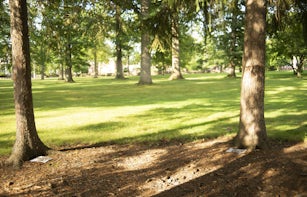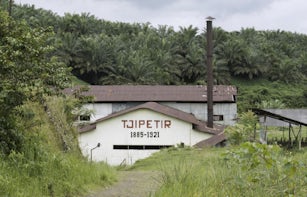In 1982, the Brazilian writer Carlos Drummond de Andrade published a full-page poem in the newspaper Jornal do Brasil. In this heartfelt elegy, titled ‘Farewell to Seven Falls’ (‘Adeus a Sete Quedas’), he paid tribute to the Guaíra waterfalls near the border of Brazil and Paraguay. This stunning hydro-geological formation was situated at a narrow gorge where the Paraná River was funnelled into eighteen cataracts clustered in seven groups that cascaded down more than one hundred metres. Such was the power of the Sete Quedas that the sound of the water could be heard 20 miles (32 km) away. However, to create a huge dammed body of water that would feed the Itaipú hydroelectric plant – a joint venture with General Alfredo Stroessner’s dictatorship in Paraguay and still the second largest plant in the world – Brazil’s military dictatorship mandated the flooding of the land where the falls were located. Once submerged, the Brazilian government exploded the waterfalls’ rock face to ensure smooth passage for any vessels across the reservoir. A natural monument had been reduced to rubble. The river had become a wall. 01
In his poem, Drummond de Andrade lamented the waterfalls’ destruction, criticising the instrumentalisation of the falls as a mere resource, its flows reduced to a series of numbers for electricity generation. By appropriating and inverting the transactional language of costs and benefits used to justify infrastructural projects, he countered the hydroelectric company’s claims that the dam was ‘building the big Brazil’ and instead alleged that the loss of Sete Quedas was detrimental rather than favourable to well-being:
And [this monument] crumbles
due to technocratic intervention.
Here seven visions, seven sculptures
of liquid profile
dissolve among computerized calculations
from a country that is no longer human
to become a chilly corporation, nothing more.
Movement becomes a dam,
from the agitation comes corporate
silence of a hydroelectric project.
We will offer every comfort
provided by the light and energy sold
at the expense of a priceless good
that cannot be rescued, impoverishing life
in the fierce illusion of enriching it. 02
The poem describes how the concrete wall that dammed the River Paraná stunted its free flows and replaced their thundering noise with ‘corporate silence’ as the reservoir drowned geology, communities and the ecosystem in the name of national progress and development. The engulfed landscape lost beneath the reservoir is what Rob Nixon in Slow Violence: Environmentalism of the Poor calls the ‘submergence zone’, a political and spatial realm created through the physical and imaginative displacement of communities considered out of sync with industrial and urban modernity. Reading the rise of megadams as the symptom of a drowned commons, Nixon criticises the ‘discourses of environmental and cultural utilitarian control, whereby the convergent unruliness of “irrational” river people and an “irrational” river must be straightened out and channeled into a national culture of rational development.’ 03 The developmentalist ideology that justifies the treatment of river communities as anachronisms that inhibit globalisation and economic growth is buttressed by the military-industrial complex of visuality, a set of optical technologies and modes of representation that render the landscape as terra nulis – an unpopulated resource carved up by maps, plans, and satellite photographs that reflect the high modernist optics of macro-planning and the legacy of colonisation. 04 Today, there can be no doubt as to the enduring hegemony of hydropower. The cumulative weight of dams has tilted the planet’s axis, generating perhaps the most compelling proof of the impact of the Anthropocene. At the same time, catastrophic failures of dam infrastructure, like the twelve-million-cubic-metre river of mud unleashed by the fatal collapse of the Brumadinho tailings dam in Brazil in January 2019, call for a revision of human impact on the environment and the role of transnational capital in ecological disasters.

n her ongoing project Be Dammed, the Colombian artist Carolina Caycedo intervenes in the submergence zones and visual regimes linked to megadam projects, exploring the politics and economics of hydraulic systems in her native Colombia and in other Latin American countries, as well as in the global context of transnational capital and the international development agencies that finance major projects in the Global South. Interwoven through her practice are a variety of media, including performance, installation and collaborations with social movements and communities affected by dam projects and infrastructural disasters. Caycedo seeks to decolonise river ecologies by creating countervisualities to the imaginaries that frame rivers as passive resources to be commodified and put to work by human capital and labour. The immersive audio-visual works, performance-based and tactile works insist on the ways that disobedient bodies act as counterflows to structures of containment mobilised by regimes of extraction and mechanisms of social control writ large. Caycedo’s work brings to the fore an understanding of rivers as dense liquid ecologies where human and more-than-human material worlds are entangled and where indigenous knowledges persist even amid the imposition of Western ‘reason’.
Walls and rivers are motifs for thinking hydraulic order in an expanded sense that goes beyond their literal physical condition. Systems of flow control invite reflection about the built infrastructures that regulate the movement of bodies and matter; the economic models through which capital flows, trickles down or stagnates; and the structures and disciplines through which ideas and media circulate. At the same time, thinking about hydraulics calls attention to those marginal communities and residual ecologies that exceed dominant socio-spatial structures and circuitries that channel material, economic and cultural flows. 05 This tension between containment, overflow and counterflow runs through Be Dammed, where apparently solid and structured walls and masses repeatedly take fluid forms of ‘rivers’ that overflow the logics of hydraulics and productivity. In the performance work Beyond Control (2013–16), even as a group of people is corralled tight into the corner of the gallery, individual bodies continue to agitate and move together. 06In the Geochoreographies (2014), a series of community initiatives intersecting ‘social justice and environmental practices with creative, collaborative and aesthetic praxis’, bodies occupy river spaces in leisure activities orientated toward solidarity not profit, and leisure not work.07 Rivers are also made to defy containment in the series of Water Portraits (2016) where they appear in mirrored photographs printed onto long draped canvases that cascade and unfurl into the gallery space, and in the video work Land of Friends (2014) where a hand traces a line of ink over a satellite view of a river’s course to signal its detours and alternate routes beyond the fixity of the photograph. 08




